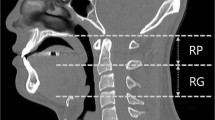Abstract
Purpose
Obstructive sleep apnea syndrome (OSAS) is characterized by upper airway inflammation. The aim of this study was to characterize thermal profile of the antero-cervical region in OSAS patients through medical thermal imaging and to compare the respective subjects with non-OSAS individuals.
Methods
Image capture followed the Glamorgan Protocol. A dynamic thermographic examination of the anterior cervical region (at baseline and after a cold stimulus) was conducted in 26 patients diagnosed with overnight polysomnography (PSG). PSG results stratified the subjects into OSAS and non-OSAS groups and their thermograms were compared.
Results
Eleven non-OSAS and 15 OSAS subjects were evaluated. Antero-cervical right side (RS) temperature was higher in OSAS group at baseline (p = 0.014). Right side index (RSI) temperature—the difference between RS and submental region, considered as control—was lower in OSAS subjects at baseline (p = 0.020) and 10 min after the cold stimuli was applied (p = 0.008), indicating higher absolute temperatures in this group. Left side index (LSI) was also lower at 10 min in OSAS group (p = 0.021). Statistical correlation was found between apnea-hypopnea index and RS at baseline (r = 0.424, p = 0.031) and at 10 min (r = 0.403, p = 0.041) and RSI at baseline (r = − 0.458, p = 0.019) and 10 min after cold provocation was applied (r = − 0.435, p = 0.025).
Conclusions
OSAS patients have shown higher antero-cervical temperatures compared with non-OSAS counterparts and temperature was associated with severity of the condition. Medical thermography may be a suitable tool in the setting of OSAS suspicion.


Similar content being viewed by others
References
Young T, Palta M, Dempsey J, Skatrud J, Weber S, Badr S (1993) The occurrence of sleep-disordered breathing among middle-aged adults. N Engl J Med 328:1230–1235. https://doi.org/10.1056/NEJM199304293281704
Sateia MJ (2014) International classification of sleep disorders-third edition: highlights and modifications. Chest 146:1387–1394. https://doi.org/10.1378/chest.14-0970
Toraldo DM, De Nuccio F, De Benedetto M, Scoditti E (2015) Obstructive sleep apnoea syndrome: a new paradigm by chronic nocturnal intermittent hypoxia and sleep disruption. Acta Otorhinolaryngol Ital 35:69–74
Garvey JF, Pengo MF, Drakatos P, Kent BD (2015) Epidemiological aspects of obstructive sleep apnea. J Thorac Dis 7:920–929
Salerno FG, Carpagnano E, Guido P, Bonsignore MR, Roberti A, Aliani M, Vignola AM, Spanevello A (2004) Airway inflammation in patients affected by obstructive sleep apnea syndrome. Respir Med 98:25–28
Carpagnano GE, Lacedonia D, Foschino-Barbaro MP (2011) Non-invasive study of airways inflammation in sleep apnea patients. Sleep Med Rev 15:317–326. https://doi.org/10.1016/j.smrv.2010.12.005
Aihara K, Oga T, Chihara Y, Harada Y, Tanizawa K, Handa T, Hitomi T, Uno K, Mishima M, Chin K (2013) Analysis of systemic and airway inflammation in obstructive sleep apnea. Sleep Breath 17:597–604. https://doi.org/10.1007/s11325-012-0726-y
Fortuna AM, Miralda R, Calaf N, González M, Casan P, Mayos M (2011) Airway and alveolar nitric oxide measurements in obstructive sleep apnea syndrome. Respir Med 105:630–636. https://doi.org/10.1016/j.rmed.2010.12.004
Philippe C, Boussadia Y, Prulière-Escabasse V, Papon JF, Clérici C, Isabey D, Coste A, Escudier E, d’Ortho MP (2015) Airway cell involvement in intermittent hypoxia-induced airway inflammation. Sleep Breath 19:297–306. https://doi.org/10.1007/s11325-014-1019-4
Olopade CO, Christon JA, Zakkar M, Swedler WI, Rubinstein I, Hua CW, Scheff PA (1997) Exhaled pentane and nitric oxide levels in patients with obstructive sleep apnea. Chest 111:1500–1504. https://doi.org/10.1378/chest.111.6.1500
Jones BF, Plassmann P (2002) Digital infrared thermal imaging of human skin. IEEE Eng Med Bio Mag 21:41–48
Teichmann D, Brüser C, Eilebrecht B, Abbas A, Blanik N, Leonhardt S (2012) Non-contact monitoring techniques—principles and applications. Conf Proc IEEE Eng Med Biol Soc:1302–1305
Hildebrandt C, Raschner C, Ammer K (2010) An overview of recent application of medical infrared thermography in sports medicine in Austria. Sensors (Basel) 10:4700–4715
Murthy JN, van Jaarsveld J, Fei J, Pavlidis I, Harrykissoon RI, Lucke JF, Faiz S, Castriotta RJ (2009) Thermal infrared imaging: a novel method to monitor airflow during polysomnography. Sleep 32:1521–1527
Hers V, Corbugy D, Joslet I, Hermant P, Demarteau J, Delhougne B, Vandermoten G, Hermanne JP (2013) New concept using Passive Infrared (PIR) technology for a contactless detection of breathing movement: a pilot study involving a cohort of 169 adult patients. J Clin Monit Comput 27:521–529. https://doi.org/10.1007/s10877-013-9457-2
Ammer K (2008) The Glamorgan Protocol for recording and evaluation of thermal images of the human body. Thermol Int 18:125–144
Schwartz RG (2006) Guidelines for neuromusculoskeletal thermography. Thermol Int 16:5–9
Ring EFJ, Ammer K (2000) The technique of infrared imaging in medicine. Thermol Int 10:7–14
Vardasca R, Ring EFJ, Plassmann P, Jones CD (2012) Thermal symmetry of the upper and lower extremities in healthy subjects. Thermol Int 22:53–60
Bouloukaki I, Mermigkis C, Tzanakis N, Kallergis E, Moniaki V, Mauroudi E, Schiza SE (2017) Evaluation of inflammatory markers in a large sample of obstructive sleep apnea patients without comorbidities. Mediat Inflamm 4573756:1–13
Waalen J, Buxbaum JN (2011) Is older colder or colder older? The association of age with body temperature in 18,630 individuals. J Gerontol A Biol Sci Med Sci 66:487–492. https://doi.org/10.1093/gerona/glr001
Vardasca R, Simões R (2013) Current issues in medical thermography. In: Tavares JMRS, Jorge RM. Topics in medical image processing and computational vision. Dordrecht, Springer Sci Bus Media 2013; pp. 223–237.
Acknowledgments
The authors acknowledge the personnel in the Pulmonology Department of São João Hospital and Dr. Camila Dias from the Department of Information Sciences and Health Decision of Faculty of Medicine, University of Porto.
Author information
Authors and Affiliations
Corresponding author
Ethics declarations
Conflict of interest
The authors declare that they have no conflict of interest.
Ethical approval
All procedures performed in studies involving human participants were in accordance with the ethical standards of the institutional and/or national research committee and with the 1964 Helsinki declaration and its later amendments or comparable ethical standards.
Informed consent
Informed consent was obtained from all individual participants included in the study.
Rights and permissions
About this article
Cite this article
Jarnalo, M., Vardasca, R., Mendes, J.G. et al. Antero-cervical thermophysiological characterization of obstructive sleep apnea patients. Sleep Breath 22, 1111–1116 (2018). https://doi.org/10.1007/s11325-018-1644-4
Received:
Revised:
Accepted:
Published:
Issue Date:
DOI: https://doi.org/10.1007/s11325-018-1644-4




